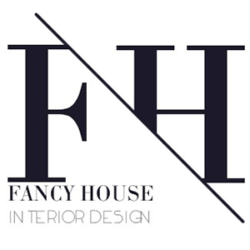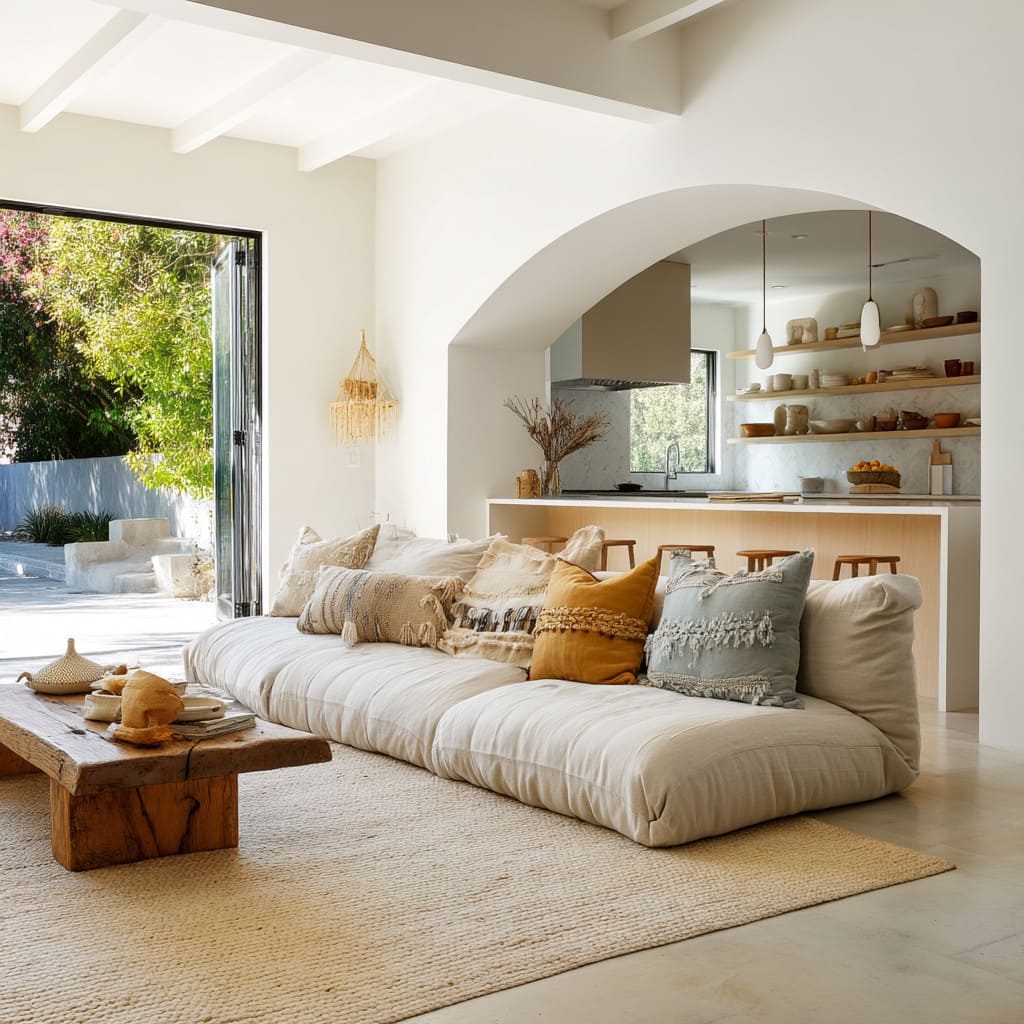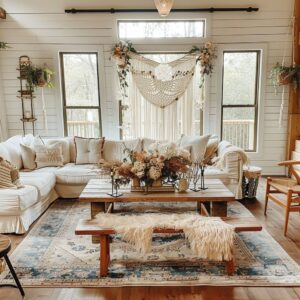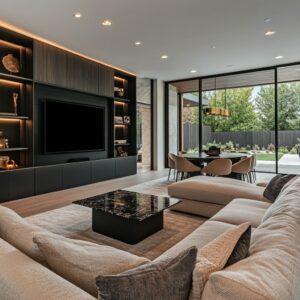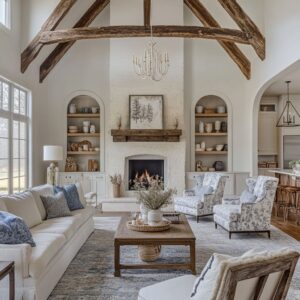Fresh interpretations of Moroccan style are quietly reshaping how living rooms feel across different parts of the world, especially in homes where relaxed architecture and warm materials take center stage. Instead of relying on busy colors and ornate patterns, today’s moroccan style living room ideas focus on texture, mass, and the honest beauty of handmade elements.
The influence runs deeper than surface looks. It’s found in the thickness of plastered walls, the raw softness of travertine tables, and the way a single woven pendant can guide the mood of a space.
Low seating arrangements, deep-set windows, and sculptural furniture pieces all reflect the spirit of Moroccan tradition, but through a contemporary, breathable lens that fits effortlessly into modern homes.
Many new interiors pull from the quiet confidence of Moroccan courtyards and salons, adapting their sense of community, craft, and openness without falling into imitation. Whether in a coastal house, a desert villa, or a suburban retreat, the atmosphere grows out of proportion, material honesty, and an instinctive respect for light and shadow.
In this article, we look closely at the thoughtful details and subtle ideas shaping the freshest ways to bring Moroccan inspiration into everyday living rooms.
Main Trends: Quiet Moroccan Motifs in Modern American Framing
| Aspect | How the rooms reinterpret Moroccan heritage | Subtle gain for today’s homes |
|---|---|---|
| Geometry |
| Gives a gentle break from the straight-line drywall box while avoiding ornate plasterwork that would feel out of place in most U.S. builds |
| Seating Height & Layout |
| Users sit nearer to the coffee table, creating an informal, hands-on social core—ideal for conversation or board games instead of formal lounging |
| Inside↔Outside Gradient |
| Yields a layered buffer zone that controls glare and heat while still feeling part of the landscape—important for sunbelt climates |
Texture Layering Tactics
Texture plays an unusually quiet but powerful role in shaping a fresh moroccan design living room today. Instead of filling walls or furniture with heavy patterns, designers build richness through surfaces that catch light unevenly and create natural movement without relying on color shifts.
One of the most effective techniques is the use of micro-relief surfaces. Stacked stone strips arranged horizontally, the soft ribbing of corduroy poufs, and fireplaces finished with a gently pitted plaster surface all contribute to a layered shadow effect.
These elements make the walls and furniture feel alive under changing daylight, without adding weight or crowding the space visually.
Rather than scattering multiple pieces across a room, a single statement weave often takes center stage. A group of simple handwoven baskets arranged thoughtfully on a wall, or a single large carved mashrabiya panel, becomes the main artwork by letting light pass through or reflect off the textures.
The movement of sunlight across these surfaces tells a story that feels connected to the spirit of Moroccan living, without overwhelming the room with too many objects.
One-object storytelling is another quiet but defining feature. Designers select one large, meaningful piece—like a hand-thrown ceramic jar, a rattan cloche with soft natural irregularities, or a bold travertine bowl—to anchor a vignette.
Instead of busy clusters of accessories, the space breathes around a single handcrafted form, making it feel grounded and intentional. This restraint brings a fresh energy to rooms inspired by traditional Moroccan living room style, while keeping everything adaptable for modern lifestyles.
Material Intelligence
| Cluster | Specific moves that go beyond the obvious | Why they resonate now |
|---|---|---|
| Plaster & Stone | Tadelakt spirit without tadelakt labor—many rooms specify hand-troweled lime or gypsum plaster, then stop before the high-gloss polish. Fireplaces and hood canopies pick up soft light without drawing glare | The finish is breathable, palm-friendly to the touch, and forgiving of hairline cracks—crucial in shifting wood-frame houses |
| Travertine & Limestone Blocks | Rather than thin slabs, designers choose thick-edged monoliths, Side faces often reveal chisel marks or unfilled voids | The unresolved edges feel handcrafted, but the sheer mass keeps the room from looking “decorated”; it feels built-in even when pieces are movable |
| Raw Timber, Live-Edge Shelves | Single-plank floating ledges replace full bookcases. No brackets visible—just thick shims | Keeps sightlines clear, showcases one pottery group instead of many trinkets, and lets drywall expand/contract around the wood |
Furniture Proportions & Ergonomics
Furniture choices in a modern moroccan living room style focus strongly on proportions that invite relaxation without sacrificing structure. Coffee tables, for example, tend to sit noticeably lower than typical American standards—averaging around 12 to 14 inches in height.
This subtle adjustment shifts the whole room’s dynamic, encouraging sitters to lean in naturally and connect with the group around them, just as people do in more traditional lounge settings.
Sofas take on a deeper, more lounge-driven character as well. Many show seat depths ranging between 26 and 30 inches, a marked difference from the narrower depths commonly found in standard suburban homes.
These deeper seats echo the comfort and grounded feeling of floor-cushion arrangements seen throughout Moroccan homes, without requiring people to actually sit on the floor. It shapes an atmosphere where lingering feels natural, not formal or rigid.
As for poufs and ottomans, designers steer clear of predictable round leather versions with stitched embroidery. Instead, the focus is on chunky woven cubes, faux-shearling barrel shapes, or low, raw-timber stumps.
These pieces add texture, character, and versatility to the room without falling into clichés. Their simple, honest shapes and tactile materials fit easily into different types of homes, while maintaining the soulfulness and relaxed character that makes Moroccan design feel so timeless today.
Lighting Language
| Technique | Moroccan root | Modern shift seen in the notes |
|---|---|---|
| Oversized woven or paper pendants hung low | Hand-braided reed or palm lanterns | Bulbs tucked into frosted globes to avoid sharp filaments; overall wattage low, counting on daylight to supply brightness |
| Brass pencil-thin pendants | Slender metal lanterns | No filigree; pure cylinder tubes to read as jewelry, not craft market souvenirs |
| Minimal wall sconces | Candle niches | Linen shades diffuse up-glow, protecting the plaster finish from heat stains |
Hidden gain: All selected fixtures cast soft ellipse shadows that echo the room’s arches, reinforcing form continuity after sundown.
Less-Spotted Motifs Are Favoring
Across many of the latest moroccan living room ideas, a softer and more thoughtful use of artisanal elements is replacing the obvious and over-decorated looks that once dominated. Instead of heavy surface treatments, subtle craftsmanship details bring character without shouting.
One of the more intriguing moves is the carved-edge coffee table, where tool marks are left visible only on the underside lip of the tabletop. To the eye, the surface remains calm and clean, but fingertips brushing underneath feel the irregular shaping—a quiet reminder of handwork without making the surface look distressed or overly rustic.
Another detail gaining attention is the use of half-height plaster returns around windows, rethinking the traditional mashrabiya concept. These low, thick ledges not only create a casual seating spot or plant perch but also help in diffusing light and providing passive solar shading, echoing the shaded comfort typical of Moroccan homes.
Quiet alcove shelving is another touch that designers are bringing into the conversation. Rather than attaching bulky casegoods, recessed niches are cut flush into walls so that curated objects—simple ceramics, handwoven baskets, or worn clay pieces—feel part of the architecture itself.
This approach strengthens the sense of permanence and heritage without crowding the room.
Texture continues to drive visual rhythm. One-color basket walls have started to replace collections filled with mixed dyes and patterns.
By focusing on variations of a single earthy tone, texture becomes the main actor, allowing rooms to breathe and making the styling process feel much more natural and flexible.
Finally, before any artwork is considered, many spaces now introduce a ceiling gesture—whether through soft wave-formed soffits or a rhythm of exposed pale beams. This move quietly sets the entire emotional tone of the room, meaning any later layering of art or decor can stay minimal and intentional.
These understated choices point toward a future of moroccan interior design living room spaces that feel crafted, lasting, and quietly luxurious, without slipping into themes or heavy-handed references.
Why This Approach Resonates
The growing love for these quieter Moroccan influences in contemporary living rooms speaks to a strong desire for homes that feel grounded, textural, and durable without fuss. First, there’s the reality of low-maintenance luxury.
Surfaces like stone, soft lime plasters, and slipcovered linen offer a lived-in beauty that shrugs off daily use much better than high-gloss finishes. Scratches, small scuffs, and the passing of time only add richness to these materials, rather than degrading their appearance.
Second, the new take on Moroccan styling leans into wellness through tactility. Hand-smoothed plaster walls, chunky woven fabrics, and raw timber accents bring in a tactile quality that’s deeply calming in an age where most homes are filled with screens and slick surfaces.
Touching these materials provides a grounding effect that polished plastics or synthetic finishes simply cannot replicate.
Lastly, and perhaps most importantly, this interpretation shows a commitment to cultural respect without costume. Rather than copying visual motifs or layering in obvious props, designers are pulling deeper ideas from Moroccan design—such as proportions, hand-formed textures, and community-driven layouts.
It honors the spirit without freezing it into a caricature, making the style feel fresh, respectful, and enduring for many types of American homes today. In this way, the quieter Moroccan living room style offers something deeper and more lasting—spaces shaped by memory, material, and connection, rather than decoration alone.
Regional Adaptation Patterns
| Region | Moroccan cue retained | Local adjustment |
|---|---|---|
| Desert Southwest | Stone mass, cactus sightlines | Larger eave overhangs for glare control; sandstone tones match local soil, so rooms feel site-specific |
| Pacific Coast | Indoor-outdoor blur, plaster, linen | Marine air demands lime-wash topcoat over plaster to resist salt; fabrics skew to slipcovers for easy laundering after beach use |
| Southeast & Gulf | Zellige-inspired glossy tiles, woven lamps | Humidity addressed with lighter open-weave rugs and ceiling fans disguised as sculptural timber blades |
| Northeast & Midwest | Heavy niches, carved wood artifacts | Heating vents concealed in raised hearths; thicker insulation behind plaster eliminates cold-wall effect while keeping look intact |
Final Pointers
One of the strongest visual anchors in a moroccan modern living room is the way the furniture arrangement builds from the ground up. Starting with one massive, low coffee table establishes a clear horizon line that the rest of the seating can reference.
This subtle structure immediately sets a grounded, cohesive feeling across the room, even before any decor is added.
Walls are no longer treated simply as barriers. In today’s fresh interpretations, they act like functional furniture pieces.
Recessed niches, half-height benches tucked below windows, and quiet built-in shelves add a sculptural depth to the architecture while freeing up floor space. This strategy brings layered richness to the space without needing to add bulky cabinets or standing furniture.
The use of color remains intentionally sparse but grounded in earthy roots. If terracotta shades appear, they come through textured surfaces rather than glossy finishes.
When touches of indigo are introduced, they arrive woven into fabrics or softened by matte textures, staying true to the spirit of handwork and material honesty rather than bold surface treatments. Lighting takes on a sculptural role too.
Oversized woven pendants paired with dimmable LED setups allow the light to create moving shadow patterns across walls and ceilings. This quiet animation makes the room feel alive during different times of day, eliminating the need for heavy decorative elements that might otherwise crowd the space.
Finally, architectural curves are treated with discipline. Curves frame the major transitions—doorways, fireplace fronts, or ceiling edges—where they naturally belong.
Allowing too many small arches scattered throughout the space risks making the design feel like a theme rather than a living, breathing part of the home.
By focusing on proportion, grounded massing, and the honest beauty of raw materials—and letting the natural play of daylight handle much of the mood-setting—today’s homes carry the soul of Moroccan craftsmanship without falling into imitation. Every element breathes quietly, allowing the spirit of tradition to feel both meaningful and comfortably at home in a modern setting.
